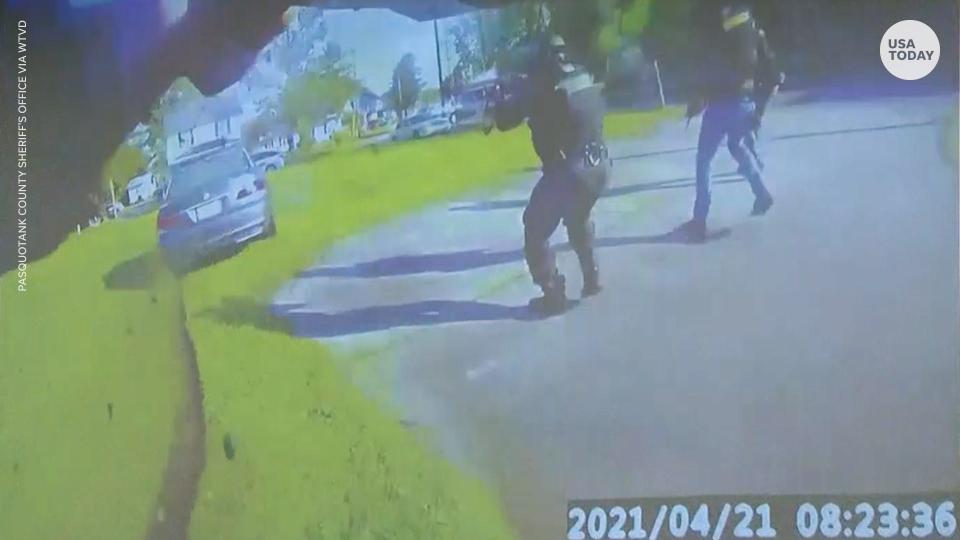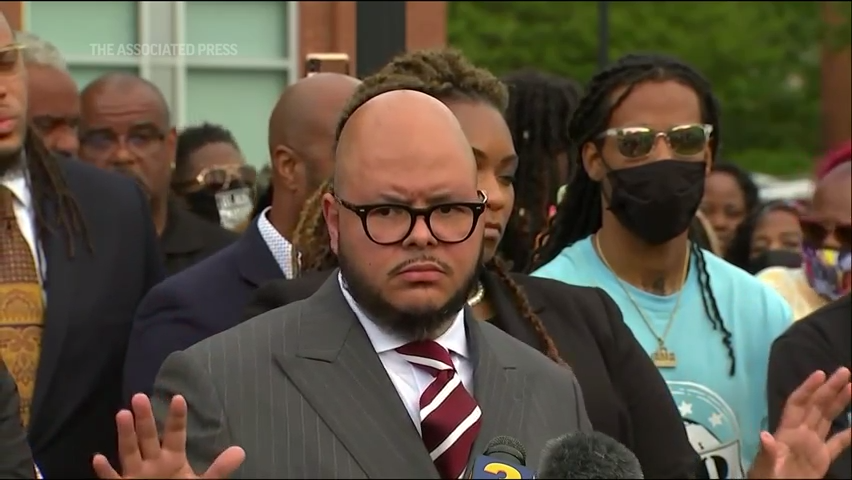Police see a threat. Family sees fear. Expert sees clips of Andrew Brown Jr. show 'everything wrong with policing'.
Corrections and clarifications: This story originally provided an incorrect title for Ken Cooper. He's director of THT of New York, a New York state-certified firearms and security training academy.
To one law enforcement expert, the body camera footage shows Andrew Brown Jr. fleeing in a panic, driving recklessly and posing a threat to nearby deputies and members of the public.
To a civil liberties advocate, the same videos show a scared Black man trying to flee a phalanx of deputies with their guns drawn by driving across a lawn at a relatively modest speed.
Video of Brown's death, shown Tuesday, is like bodycam videos of similar deaths: It supports the beliefs of the person who sees it. Police experts who understand officers are trained to stop threats look at whether the deputies followed policy. Civil rights advocates who have seen Black men killed after confrontations spiral out of control see how Brown's death could have been avoided.
Underlying it all are laws and court rulings that give law enforcement officers the benefit of the doubt.
Why bodycams haven't lived up to promises of exposing misconduct: The police decide what to release.
Brown, 42, was shot April 21 in Elizabeth City, North Carolina, after Pasquotank County deputies attempted to serve him with arrest warrants. The deputies shot Brown five times, including once in the back of his head, according to an independent autopsy commissioned by his family.
Andrew Womble, the district attorney, showed clips and photos from body-worn cameras at a news conference Tuesday as he laid out why Brown's fatal shooting was "justified" under the law. He said the deputies would not face criminal charges.
"Brown threatened the life and safety of the officers on the scene and any possible civilian bystanders, giving a reasonable officer a compelling reason to end the encounter," Womble said. "The law does not require officers in a tense or dangerous situation to wait until the moment a suspect uses a deadly weapon to act to stop the suspect."
For Chad Marlow, senior policy counsel for the American Civil Liberties Union, the bit of body camera video played for the public "is a nutshell of everything wrong with policing in America."
"They jump out of a car to arrest a Black man with assault rifles drawn. They have body camera footage but won’t let reporters see it," Marlow said. "When he is driving, they fire repeatedly into the car as if they don't care if the Black man lives or dies."
The three deputies who fired at Brown were allowed to keep their jobs but will be disciplined and retrained because "this was a terrible and tragic outcome, and we could do better," Pasquotank County Sheriff Tommy Wooten said in a video statement.
Deputies converged on Brown in his car
The body-camera footage shown Tuesday came from four of the deputies. Two others did not turn their cameras on. It shows deputies jumping out of a pickup and running toward a blue BMW with their weapons drawn, including at least one semiautomatic rifle.
The deputies surrounded the car, yelling at Brown to put his hands up.
Sgt. Joel Lunsford tried to reach for the driver's door handle, and Brown backed the car up, causing Lunsford to fall on the hood of the car, Womble said. The deputies shouted at Brown in expletive-strewn language to stop.
Brown made a tight left turn away from at least three deputies, and the bumper passed Lunsford, who jumped back and put his hand on the car.
At that point, the first gunshot was fired.

Brown drove away from the deputies, across a grassy lot, as gunfire continued for about four seconds. His car narrowly missed an unmarked law enforcement vehicle. Brown's vehicle ended up in a driveway less than a block away.
The deputies ran to the car and shouted for Brown to put his hands up. When they opened the door, a deputy said Brown had a gunshot wound, and others said to call an ambulance.
In explaining why the deputies wouldn't face charges, Womble said Brown's car was headed directly at a law enforcement officer in the unmarked vehicle, and other deputies were in vehicles nearby.
'How was he a threat?'
One reason for the divergent views of what happened that day is that most of the body camera video has not been released. North Carolina law does not consider it a public record, and its release requires a court order.
Last month, a North Carolina judge prevented the public release of the video and limited the family to seeing roughly 18 minutes out of more than two hours of available footage that includes events before and after the shooting. The judge allowed the faces of the deputies to be blurred.
Chance Lynch, the Brown family attorney, said they saw a mishmash of footage taken from several body cameras during the same time span, totaling about 18 minutes.
The Sheriff's Department said the entire incident took 20 seconds, and the family was allowed to watch it repeatedly. Lynch said knowing what was said before, during and after the incident is crucial to understanding the officers' states of mind.

Tuesday, Lynch petitioned the court to allow the family to see the full, unredacted body camera footage, as well as other video, audio, still images and details from the State Bureau of Investigation's probe.
Lynch said the family plans to file a federal civil rights lawsuit against the deputies and the sheriff's office, and he hopes the Justice Department will "take a role in this."
Because the deputies' faces were blurred, Lynch said he had trouble determining who did what. What was clear to him and the family was that Brown turned his car to the left and tried to get away.
"How was he a threat when he went across the grass and he was going the opposite direction?" Lynch asked.
Scott Greenwood, a prominent constitutional rights attorney, said it did not appear to him that Brown's vehicle presented a danger to deputies or was used as a weapon. He said the full video would give a clearer picture.
"The public will never be able to fully understand what happened in North Carolina without access to the entire body-worn camera video," Greenwood said. "It's not sufficient just for prosecutors to say, 'Just trust us, we know what we’re doing, and we’ll do the right thing' when they refuse to disclose the video and they have the ability to do so."
A permissive legal standard on force
The Fourth Amendment and a 1989 U.S. Supreme Court Case, Graham v. Connor, recognize that law enforcement officers have difficult jobs and must make split-second decisions without knowing everything about the circumstances.
The constitutional standard is to examine the mindset of the officer who shot in that moment and compare it to what a reasonable officer would do in the same circumstance, with the same knowledge of the situation.
Officers who are in fear of their lives are often given discretion to use deadly force, which is almost always considered justified.
Womble said Brown's vehicle made contact with Lunsford twice.
"Brown's precise speed in attempting to flee and striking Deputy Lunsford is uncertain," Womble said, "but that he drove recklessly and endangered the officers is not uncertain."
Under many police departments' policies, officers are not permitted to shoot at a vehicle if an officer can get out of the way – as long as the suspect isn't shooting at officers.
The Pasquotank County Sheriff's Office policy says deputies should "take reasonable steps to move out of the path of an approaching vehicle instead of discharging their firearm" when they can.
They should shoot only if they "reasonably" believe there's no other way to avoid an "imminent threat" from the vehicle or if the public or deputies are threatened by another deadly force.
The policy defines "imminent" as "impending," not immediate or instantaneous.
Police expert: Brown had 'to be stopped'
Geoff Alpert, a professor of criminology and criminal justice at the University of South Carolina, said "there was no imminent threat" based on what he saw, though he would need to see all the footage to be sure.
The district attorney's office is "not saying what (happened) was appropriate or proper," he said. "They're just saying it didn't rise to the level of a crime."
Many departments have banned shooting at moving vehicles, Alpert said, because it can present officers with a conundrum. If the person inside is killed, the vehicle becomes "an unguided missile. ... It's very likely the car will continue, and it's as likely your foot will fall on the accelerator as on the brake."
Wooten said in a written statement to USA TODAY that Pasquotank Sheriff's Office policy strongly discourages shooting at moving vehicles unless it's necessary to protect someone's life.
"As the body camera video shows, Andrew Brown’s vehicle struck a deputy with his car and then drove car directly at another deputy," Wooten said. "The deputies used deadly force to protect their lives."
Ken Cooper, director of THT of New York, a New York state-certified firearms and security training academy, said the deputies were controlled and professional in dealing with Brown. "They fired when they had to" and did not empty their magazines, as many officers do in high-stress situations.
"Our job is to protect society. This guy is out of control – he has to be stopped," Cooper said, adding that officers don't have many tools at their disposal.
"If he would’ve stopped as cops started to shoot the car, he had the opportunity to do that," Cooper said. "He was committed to do what he was going to do. If anyone was in his way, even a 5-year old, he would’ve killed them."
Marlow said it's clear Brown was "not someone trying to assault officers. That's someone trying to get away" – someone who knows what can happen to a Black man stopped by police.
Though the situation was "tragic," Womble said, deputies on the scene had no choice but to react the way they did.
"Law enforcement were duty-bound to stand their ground, carry through on the performance of their duties, and take Andrew Brown into custody," he said. "They could not simply let him go."
This article originally appeared on USA TODAY: Andrew Brown bodycam video: Clips show 2 narratives of what happened

